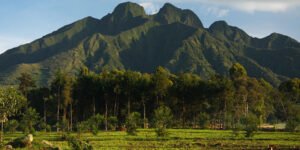


The first time I set foot in Kigali, Rwanda’s capital, I was struck not by skyscrapers or chaos, but by an overwhelming sense of order and calm. The streets were clean, bougainvillea spilled over walls, and the rolling green hills framed the horizon like a painter’s brushstrokes. It is here, in the “Land of a Thousand Hills,” that one begins to understand the best places to visit in Rwanda: landscapes that breathe with life, memorials that whisper history, and lakes where silence speaks more eloquently than words.
Rwanda is not only a destination; it is a living classroom of resilience, conservation, and cultural rebirth. To explore it is to listen—to the calls of mountain gorillas in misty forests, to the chants of fishermen at Lake Kivu, and to the silence of memorials honoring a painful past.
Why “the best places to visit in Rwanda” carry a deeper meaning
The phrase the best places to visit in Rwanda is not about tourist checklists. It is about understanding how geography, ecology, and history converge. Rwanda is small—just over 26,000 square kilometers—yet within its borders lie volcanoes, savannahs, wetlands, and urban centers that embody survival and transformation.
To visit Rwanda is to study not just nature but human perseverance. Below, we journey through hills, lakes, parks, and cities, listening to the way the earth breathes and silence speaks.
Kigali: the gateway to Rwanda’s living memory
Kigali Genocide Memorial
Every journey through Rwanda should begin in Kigali, at the Kigali Genocide Memorial. Opened in 2004, the memorial honors more than 250,000 victims of the 1994 genocide against the Tutsi. Walking through its exhibits—photographs, personal stories, mass graves—you enter a space of silence where words are inadequate. This is not simply a site; it is a reminder of humanity’s capacity for both cruelty and healing.
The pulse of a modern African city
Beyond its solemn history, Kigali is also one of Africa’s cleanest, safest, and fastest-growing capitals. Cafés line leafy streets, art galleries like Inema Arts Center showcase Rwandan creativity, and bustling markets such as Kimironko let you experience daily life. Kigali is proof that from silence, a vibrant voice can rise.
Volcanoes National Park: where gorillas breathe in the mist
Tracking the mountain gorillas
Perhaps the most famous of the best places to visit in Rwanda, Volcanoes National Park sits in the Virunga Mountains along the country’s northern border. This is the realm of the critically endangered mountain gorilla. Treks through bamboo forests and mist-draped slopes are demanding, but the moment you lock eyes with a gorilla family, all fatigue vanishes.
Conservation here is deeply tied to history. Dian Fossey’s work in these forests drew global attention to gorilla protection, and today Rwanda leads the way in conservation tourism. Permit fees directly support local communities, proving that ecotourism can be a model of sustainability.
Beyond gorillas: golden monkeys and volcanic hikes
While gorillas are the stars, Volcanoes National Park also shelters golden monkeys—playful primates found only in this region. For adventurers, hiking Mount Bisoke (with its crater lake) or Mount Karisimbi offers perspectives of the Virunga range stretching across Rwanda, Uganda, and the Democratic Republic of Congo. Here, the earth breathes through volcanic soils and mist.
Nyungwe Forest National Park: the cathedral of biodiversity
A walk in primeval forest
In Rwanda’s southwest lies Nyungwe Forest National Park, a vast rainforest often described as a “living cathedral.” One of Africa’s oldest and most diverse mountain forests, it hosts over 1,000 plant species, 322 bird species, and 13 primate species—including chimpanzees.
Walking its canopy suspension bridge is like gliding above a sea of green, with monkeys swinging below and birds darting between branches. This is one of the best places to visit in Rwanda if you wish to study ecosystems and evolutionary biology.
Chimpanzee trekking and cultural links
Chimpanzee trekking in Nyungwe offers a chance to watch our closest relatives in their natural habitat—an experience that deepens scientific and emotional understanding. Surrounding communities also participate in cultural tourism programs, sharing traditional dance, tea cultivation, and local storytelling.
Lake Kivu: where silence speaks through water
Stretching along Rwanda’s western border, Lake Kivu is one of Africa’s Great Lakes. With its tranquil waters, terraced hillsides, and fishing villages, it is a place where silence itself becomes a voice.
Gisenyi, Kibuye & Cyangugu
The lake is framed by three main towns:
-
Gisenyi (Rubavu) – a resort town with sandy beaches and lively nightlife.
-
Kibuye (Karongi) – perhaps the most scenic, with islands, boat rides, and serene bays.
-
Cyangugu (Rusizi) – quiet, bordering Nyungwe, offering intimate encounters with local life.
The science of Lake Kivu
Lake Kivu is not just beautiful; it is scientifically fascinating. It contains large reserves of methane and carbon dioxide trapped beneath its depths. Rwanda has pioneered methane extraction for energy production, turning potential risk into resource—a lesson in innovation.
Akagera National Park: Rwanda’s reborn savannah
On Rwanda’s eastern plains lies Akagera National Park, once nearly destroyed by conflict and poaching, now reborn as a thriving savannah ecosystem. Managed in partnership with African Parks, Akagera is home to the Big Five: lions, leopards, elephants, buffalo, and rhinos.
From near ruin to revival
After 1994, Akagera was heavily degraded. But through community engagement, anti-poaching units, and reintroductions of species, it now stands as one of Africa’s greatest conservation success stories. For travelers, a game drive here is a reminder that landscapes, like people, can recover from silence.
Cultural Rwanda: beyond landscapes
Huye (Butare) and the National Museum
In Huye lies Rwanda’s National Museum of Ethnography, which houses collections of traditional crafts, musical instruments, and historical artifacts. It is essential for understanding the cultural diversity that underpins Rwanda’s resilience.
Intore dance and Imigongo art
Traditional Intore dancers, with their high leaps and rhythmic drums, embody energy and storytelling. Meanwhile, Imigongo art, made from cow dung and decorated with geometric patterns, is a uniquely Rwandan expression of creativity rooted in daily life.
Connecting landscapes across Africa
When you explore the best places to visit in Rwanda, you realize the country’s story is inseparable from the land. Volcanoes whisper conservation, Nyungwe hums biodiversity, Lake Kivu murmurs silence, and Kigali speaks of rebirth.
To see how Rwanda’s voice resonates with other African landscapes, explore the best places to visit in South Africa—another country where land and history are intertwined. Both journeys reveal how earth itself narrates human and ecological stories.
Practical tips for visiting Rwanda
-
Best time to visit – June to September (dry season) is ideal for gorilla trekking and safaris. December to February is another good window.
-
Permits – Gorilla trekking permits are limited; book well in advance.
-
Transport – Rwanda’s roads are good; buses and car hires connect major towns. Domestic flights operate for longer journeys.
-
Cultural respect – Dress modestly, greet politely, and learn a few Kinyarwanda phrases like Muraho (hello).
-
Research opportunities – Rwanda is a hub for primatology, biodiversity studies, and post-conflict governance research. Scholars can find rich material across disciplines.
Conclusion: where hills breathe and silence speaks
Traveling through Rwanda is unlike any other African journey. Here, the hills seem alive, rolling endlessly like breaths of the earth. The forests hold voices of gorillas and chimps, while the waters of Lake Kivu echo in silence. Memorials remind us that silence, too, can be profound—carrying grief, healing, and hope.
When you seek the best places to visit in Rwanda, you find more than destinations. You find lessons in resilience, conservation, and the intertwining of landscape with human spirit. In Rwanda, the hills breathe—and silence speaks.


